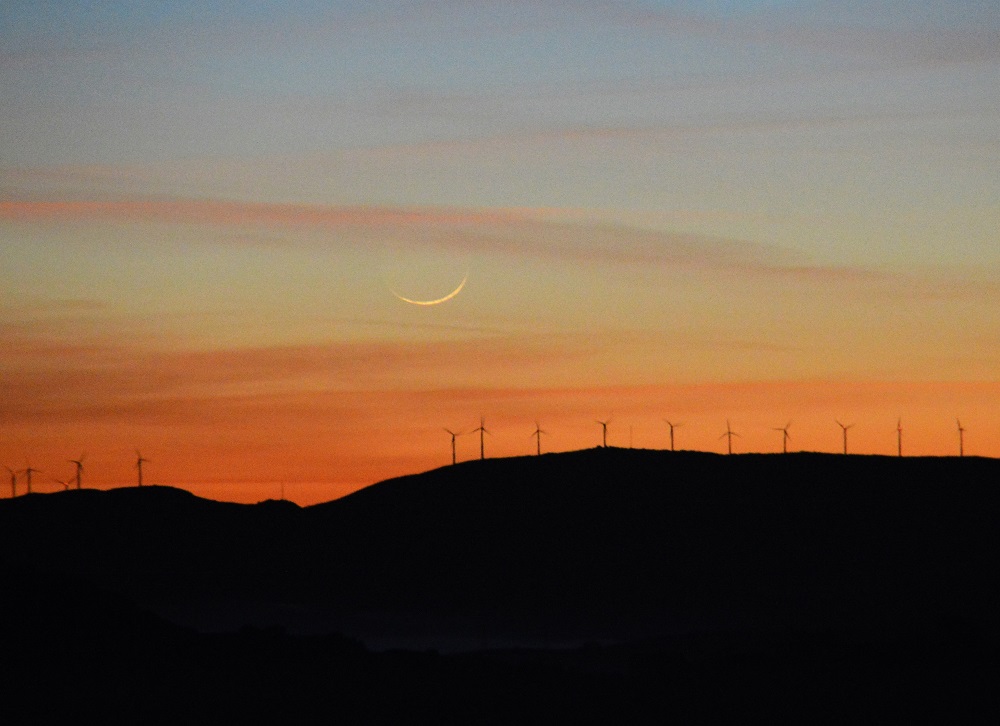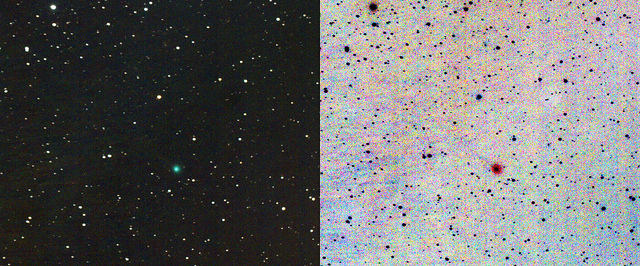Are you hanging out at home this week, and looking to observe some naked eye planets? As we mentioned last week, while Venus is shining bright in the dusk sky, all of the other four naked eye planets of Mars, Saturn, Jupiter and Mercury are skulking in the early dawn.
Continue reading “Dawn Patrol: Following this Month’s ‘March of the Planets’”Comet Encke Reemerges in the Dawn Sky
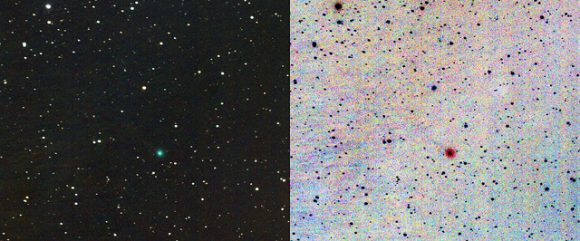
Miss out on Comet 45/P Honda-Mrkos-Padadušáková last month? We’ll admit, it was fairly underwhelming in binoculars… but fear not, there are several other binocular comets in the pipeline for 2017.
Maybe you managed to catch sight of periodic Comet 2P Encke in late February after sunset before it disappeared into the Sun’s glare. Pronounced (En-Key), the comet actually passes through the field of view of the joint NASA/ESA Solar Heliospheric Observatory’s (SOHO) LASCO C3 camera from March 8th to March 14th before reemerging in the dawn sky.
I see you… Comet 2P Encke is now in SOHO’s LASCO C3 field of view, above Mercury (the bright object) moving in the opposite direction: pic.twitter.com/gcYwv0Sdkp
— Dave Dickinson (@Astroguyz) March 10, 2017
Northern hemisphere observers have already got a sneak peek at Encke’s performance low in the dusk in February as it heads towards perihelion. Now the comet heads southward, as it vaults up into the dawn sky for folks south of latitude 30 degrees north in mid-March. From latitude 30 degrees north, Encke will clear 15 degrees elevation above the southeastern horizon around March 31st. Viewers south of the equator will have a much better viewing prospect, as Encke glides southward through Aquarius. When will you first spot it?
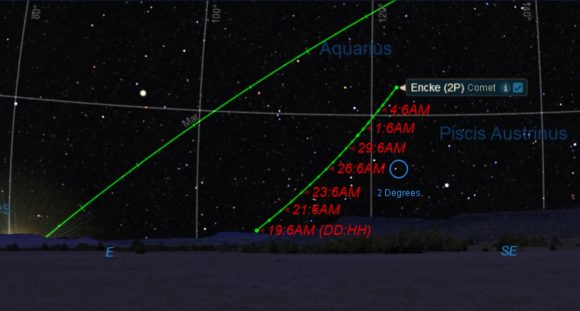
Also: don’t forget to ‘spring forward’ to Daylight Saving Time this weekend for a majority of North America prior to beginning your dawn comet vigil… Europe and the United Kingdom gets a brief reprieve ’til March 26th.
Her are some upcoming key events for Comet 2P Encke:
Closest to Sun: March 10th, with a perihelion of 0.33 AU.
Closest to Earth: March 12th, at 0.65 AU distant.
Brightest: Around March 15. Encke is currently at magnitude +7, and should top out at magnitude +6, though it’ll only be 14 degrees from the Sun on this date.
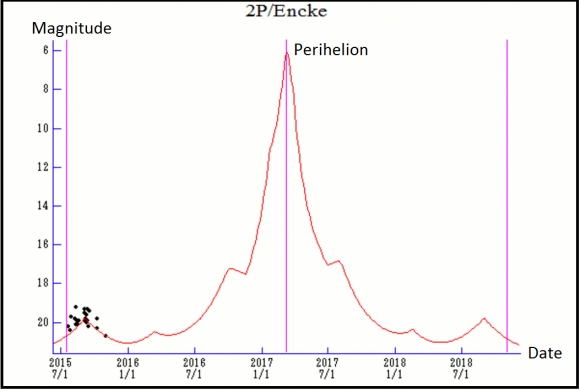
Next good apparition: 0.4 AU from Earth in 2036.
This is Encke’s 63rd passage through the solar system since Pierre Méchain linked successive passages of the comet to the same in 1819. Like Edmond Halley, Encke didn’t discover the most famous of comets that now bears his name, but instead merely deduced its periodic nature. Halley was 1st, and Encke was second (hence the “2” in 2P…) The shortest short period comet, Encke was captured sometime thousands of years ago into its short period orbit, and is destined to burn out one day as it ventures from 4.1 to 0.33 AU from the Sun. Encke is also the source of the annual Taurid meteor shower in November, notable for producing a high rate of fireballs.
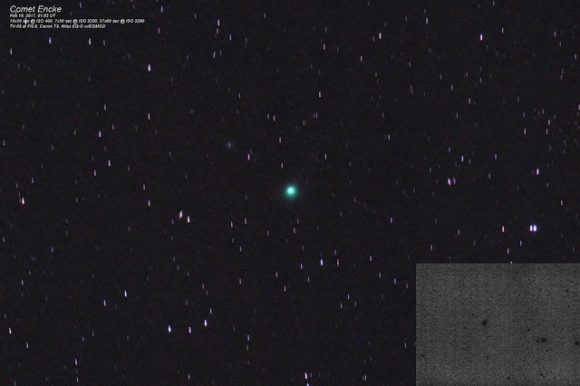
Comets can be elusive beasties, as all of that precious quoted magnitude is smeared out over an extended surface area. Add on top this the fact that comets are also notorious for often under- and occasionally over-performing expectations. Just look at the ‘none more black’ albedo of comet 67P Churumov-Gerasimenko chronicled by ESA’s Rosetta spacecraft: it’s a miracle we can see ’em at all. And finally, that low contrast dawn sky can easily hide a faint binocular comet, fading it to invisibility. Start your comet vigil early, sweeping the horizon with binocs. An early start and a clear view are key. The slim waning crescent Moon sits 12 degrees north of Comet Encke on the morning of March 26th, and the comet also passes less than 3 degrees from the Helix Nebula (NGC 7293) on (no joke) April Fool’s Day April 1st.
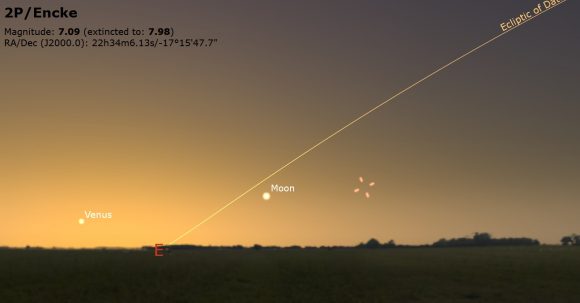
Flashback to one Encke orbit ago to 2013 and the comet provided a good dawn preshow to that biggest of cosmic let downs, Comet ISON. And although Encke makes its rounds every 3.3 years, orbital geometry assures that we won’t get another favorable viewing from Earth until 2036.
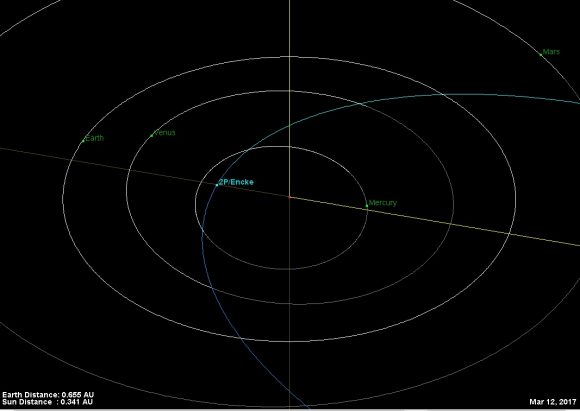
Speaking of great comets that never were, we juuuust missed having a spectacular comet this past month, when recently discovered long-period Comet 2017 E1 Borisov passes just 0.045 AU (!) interior to our orbit. Unfortunately, this occurs five months too early, with the Earth almost exactly at the wrong place in its orbit. Now, if it was only August…
Comet Teaser for 2017
Yeah, the gambler’s fallacy would tell us that we’re due for the next great comet of the century, for sure. In the meantime, we’ve still got Comets 41P/Tuttle-Giacobini-Kresák (late March/April), C/2015 ER61 PanSTARRS (May), and C/2015 V2 Johnson (June) on tap as good binocular comets in 2017.
Be sure to enjoy elusive comet Encke as it flits once more though the dawn skies.
-Read about comets, occultations, eclipses and more for the year, in our new free e-book 101 Astronomical Events for 2017 out from Universe Today.
See Mercury at its Greatest Elongation for 2013
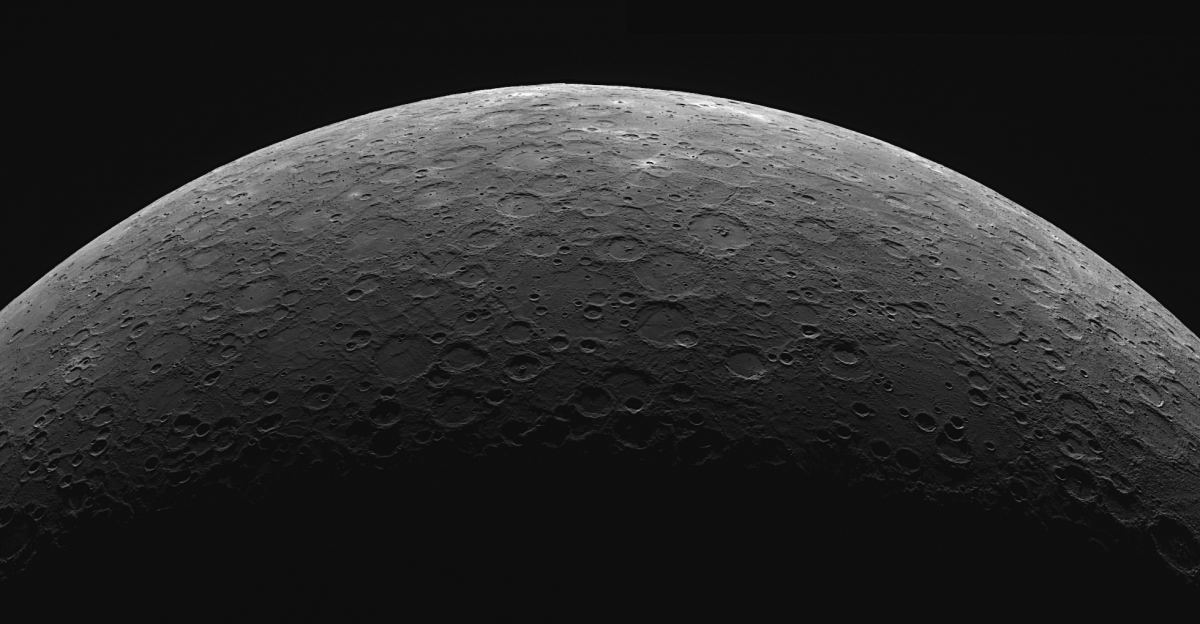
A fine apparition of the planet Mercury graces the dawn skies this week, leading up to its greatest elongation from the Sun for 2013.
It seems that nearly every appearance of the planet Mercury is touted as the “best” these days. Such was the case with the inner-most world’s dusk showing early last month. Truth is, all elongations of Mercury (and Venus, for that matter) are not created equal, and visibility of each apparition isn’t the same for observers worldwide. We’ll show you why.
Mercury orbits the Sun once every 88 days. With an orbit interior to our own, it never strays far from the Sun in the sky and thus can only appear low in the dawn or dusk. Its orbit is also elliptical, with an eccentricity of 0.206, the greatest of any planet in our solar system. This means that greatest elongations can vary considerably, from 17.9° away from the Sun in the sky near perihelion of the planet to 28.7° near aphelion. And although reaching greatest elongation near aphelion means the tiny world is above the muck of the horizon, it also means it’s also intrinsically a bit fainter; Mercury can vary in brightness from magnitude -0.2 at a perihelic-elongation to half a magnitude fainter at +0.3 for an aphelic-elongation.
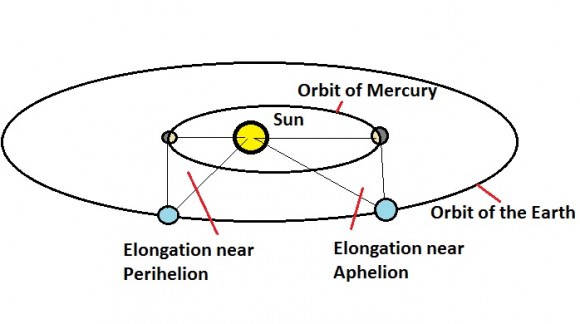
But there’s more. Compounding this situation is the angle of the ecliptic, or the imaginary plane of the orbit of the Earth. Near the March equinox the ecliptic rides high in the dusk to the west and low in the dawn to the east for northern hemisphere observers. In the southern hemisphere, the reverse is true. It’s a strange sight for a northerner to head “Down Under” and watch the Sun rise in the east, transit to the north and set to the west!
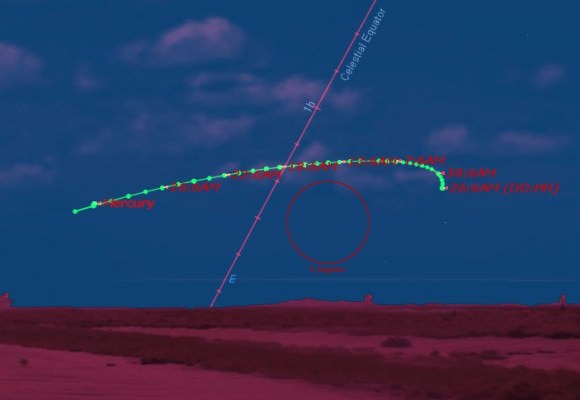
Thus what may be a terrible apparition of Mercury for one hemisphere may be a grand one for another, as is the case this week. Yes, northern observers can catch the fleeting world, if they know exactly where to look for it. For observers based at longitude 40° north, Mercury will never peak above an altitude of 10° in the dawn sky. Observers based near 35° south will however see the planet reach its maximum possible elevation of over 25° degrees above the horizon.
We would qualify this as “The best dawn appearance of Mercury for 2013… as seen from the southern hemisphere.” Greatest elongations of Mercury occur in pairs, with dusk-to-dawn apparitions about 45 days apart as the planet passes between us and the Sun, followed by a longer period of about 70 days as the world loops back around behind the Sun. The orbit of Mercury is tilted about 7° with respect to our own. Otherwise, we would see a transit of the planet every inferior conjunction, as last occurred on November 8th, 2006 and will happen next on May 9th, 2016.
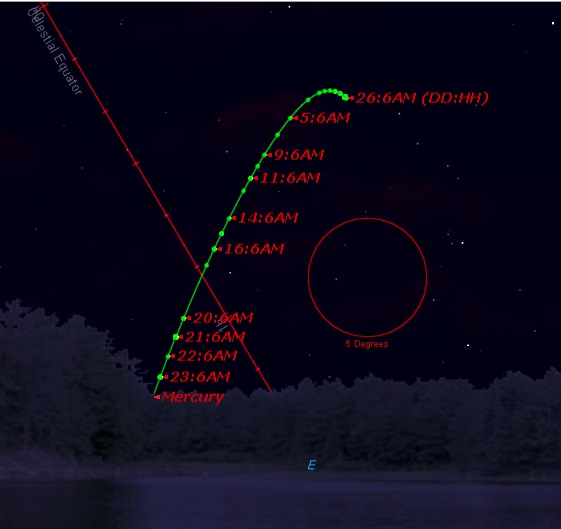
Mercury will show a maximum illumination area of 38.5” square arc seconds as seen from the Earth March 30th on just before reaching its greatest elongation west of the Sun on March 31st on Easter Day at 22:00 UT/18:00EDT. Through a telescope, Mercury will display a 7.7” diameter disk with a 50% illuminated “half-Moon” phase. Mercury reaches greatest elongation just 28 hours prior to aphelion which occurs on April 2nd, the closest this has occurred date-wise since April 8th, 2006. This won’t be matched again until March 24th, 2020. Shining at magnitude +0.3, Mercury will then race ahead of the Earth on its inside track and will begin to gradually sink lower on successive mornings in early April. The morning of April 8th may well offer the last good chance to spy the tiny world when the old crescent Moon passes just 8° degrees north of the planet within two days of reaching New phase on April 10th. Mercury reaches superior conjunction opposite to the Earth and on the far side of the Sun on May 11th, 2013, and will again head into the dusk skies for its next greatest eastern elongation on June 12th.
From our Earthly vantage point, Mercury completes 3.15 orbits of the Sun a year. This means that we see 6 greatest elongations on average most years, 3 westerns (dawn) and 3 easterns (dusk). The most elongations of Mercury that you can have in a calendar year are 7, which occurred in 2011 and will happen again in 2015. It’s fascinating to think that until the advent of the Space Age, the orbit and the rough size of Mercury was all we knew about the planet. It would take the first flyby of the Mariner 10 spacecraft to give us a close up view of Mercury in 1974. The precession of the orbit of Mercury was a mystery until explained by Einsteinian physics, and still stands as one of the great proofs of general relativity. Today, we have a permanent ambassador around Mercury, NASA’s MESSENGER spacecraft. MESSENGER has mapped to world in detail, sampled its tenuous exosphere, and observed hints of ancient volcanic activity. MESSENGER will be followed by the joint European Space Agency/Japan Aerospace Exploration Agency mission BepiColombo set to launch in 2015 which will arrive at Mercury in 2022. All fascinating things to ponder as you search for the diminutive world low in the dawn skies this coming Easter weekend!

